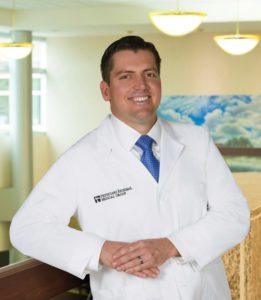

When it comes to recognition in the organ world, the gallbladder tends to be the “low man on the totem pole”.
That is until problems occur in the form of gallstones. This lesser known, pear-shaped organ sits beneath the liver and stores bile which is later released into the small intestine to aid with digestion and break down fats. When the bile becomes crystallized within the gallbladder, gallstones can form that can range in size from a speck of sand to the size of a golf ball. These can cause an infection known as Cholecystitis and get stuck inside the duct going to the small intestine resulting in severe pain. “Typically, people will feel it in the right upper quadrant of the abdominal area which can radiate to the right upper back, says Jonas Mansson, M.D., board certified general surgeon at Physicians Regional Medical Group. “Some people will experience chest pain thinking they are having a heart attack because of similar symptoms.” The pain may be associated with nausea, vomiting, and abdominal bloating.
Symptoms can be exacerbated by fatty meals that include both good and bad fats, and usually present about one hour after eating. This can last from several minutes to several hours. Dr. Mansson cautions that anyone with abdominal pain associated with fever and chills should seek immediate medical attention.
Gallstones affect more than 30 million Americans annually, and are caused by a number of factors that include hormones, high fat diet, high cholesterol diet, rapid weight gain or weight loss, and genetics. “Gallstones can run in families due to a genetic predisposition of the chemical composition of the bile in the gallbladder that cause gallstones, says Dr. Mansson.” According to a research article from the American Gastroenterological Association, highest prevalence has been found among some North American Indians, Chileans, and Mexican Americans, followed by non-Mexican Hispanics from North America.1
While anyone can get gallstones, Dr. Mansson offers the following tips to help prevent them from forming:
1) Eat a low fat/low cholesterol diet
2) Eat less meat and add more fruits and vegetables
3) Get regular exercise
Although symptoms can vary and may reoccur periodically, doctors usually recommend surgical removal to prevent any future trouble. This can be done with minimally invasive laparoscopic or robotic-assisted surgery, which requires a small incision and has minimal recovery time. The good news is most people can lead a healthy, normal life once the gallbladder is removed.
Dr. Mansson’s office is located in Naples at Physicians Regional – Pine Ridge, 6101 Pine Ridge Rd. For more information or to schedule an appointment, please call 239-348-4221, or schedule online at www.PhysiciansRegionalMedicalGroup.com
Physician Regional Medical Group
1 https://www.gastrojournal.org/article/S0016-5085(98)70266-5/fulltext
 Southwest Florida's Health and Wellness Magazine Health and Wellness Articles
Southwest Florida's Health and Wellness Magazine Health and Wellness Articles
